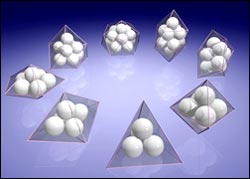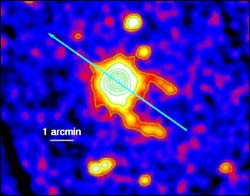This area deals with the fundamental laws and building blocks of nature and how they interact, the properties and the behavior of matter, and research into space and time and their structures.
innovations-report provides in-depth reports and articles on subjects such as astrophysics, laser technologies, nuclear, quantum, particle and solid-state physics, nanotechnologies, planetary research and findings (Mars, Venus) and developments related to the Hubble Telescope.

Astronomers from the University of Cambridge, UK, have found for the first time the true outer limits of a galaxy. They have also shown that the dark matter in this galaxy is not distributed in the way conventional theory predicts.
The team – Professor Gerry Gilmore, Dr Mark Wilkinson, Dr Jan Kleyna and Dr Wyn Evans – presents its results today at the 25th General Assembly of the International Astronomical Union in Sydney, Australia. The work could provide the key to understanding how

Three years before he received the Nobel Prize in Physics, Eugene Wigner published an article entitled “The Unreasonable Effectiveness of Mathematics in the Natural Sciences” (1960). He marveled at how often physicists develop concepts to describe the “real” world only to discover that mathematicians–heedless of that real world–have already thought up and explored the concepts. His own experience of the uncanny applicability of mathematical insights to the physical reality of quantum mechanics led

Astronomers using ESA’s X-ray observatory, XMM-Newton, have discovered a pair of X-ray tails, stretching 3 million million kilometres across the sky. They emanate from the mysterious neutron star known as Geminga. The discovery gives astronomers new insight into the extraordinary conditions around the neutron star.
A neutron star measures only 20-30 kilometres across and is the dense remnant of an exploded star. Geminga is one of the closest to Earth, at a distance of about 500 light-years.

Two University of Toronto astronomers and a U.S. colleague have made the first-ever measurements of the size and shape of massive dark matter halos that surround galaxies
‘Our findings give us the clearest picture yet of a very mysterious part of our universe,’ says principal investigator Henk Hoekstra, a post-doctoral fellow at University of Toronto’s Canadian Institute for Theoretical Astrophysics. ‘Using relatively simple physics, we can get our first direct glimpse of the size an

New research on dwarf spheroidal galaxies by a team of astronomers at the University of Cambridge promises a real astronomical first: detection, for the first time, of the true outer limits of a galaxy.
The team is presenting today (23 July 2003) at the 25th General Assembly of the International Astronomical Union (IAUXXV) in Sydney, Australia. The research could provide the key to understanding how larger galaxies were formed, including our own Milky Way galaxy.
The rare dw

Peering into a giant molecular cloud in the Milky Way galaxy – known as W49 – astronomers from the European Southern Observatory (ESO) have discovered a whole new population of very massive newborn stars. This research is being presented today at the International Astronomical Union’s 25th General Assembly held in Sydney, Australia, by ESO-scientist João Alves.
With the help of infrared images obtained during a period of excellent observing conditions with the ESO 3.5-m New Technolog